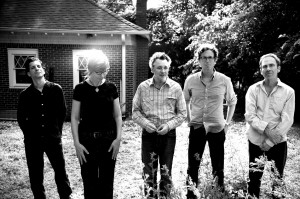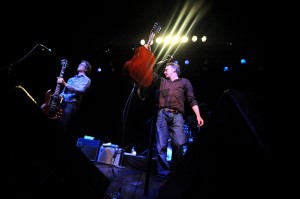Riffs, Rants & Rumors: The Jayhawks Soar Once More
posted in: Features • Rock
 When The Jayhawks first got together in 1985 Minneapolis, Gram Parsons and The Louvin Brothers did not enjoy the same kind of default-option status they command as rock-band influences today. Country-rockers were thin on the ground, outside a brace of “cowpunk” left-fielders like The Long Ryders and Jason & The Scorchers. Led by Mark Olson and Gary Louris, The Jayhawks had even more of an uphill climb on their homefront, which was doubly galling since their town had become quite the hotspot. “This town was crazy,” recalls Louris, “it was on the map, it was our time. Minneapolis was it in the mid to late ˜80s.” But the biggest things coming out of that city were the rough-edged post-punky sounds of such seminal acts as The Replacements, Soul Asylum and Husker Dü. And on the other side of the spectrum, as Louris remembers, “There was a whole ˜nother layer going on, which was Prince and The Time.” And even though The Jayhawks sported a much more aggressive sound in those early days than what the world would hear on their first album, they were just as far from the sexed-up, New Wave-tinged R&B of Morris Day and company as they were from the raw-boned rockers. “We played loud, punky, uptempo, feedback versions of Woody Guthrie songs and Hank Williams songs when we first started,” Louris reveals, and people were into it, but they didn’t know exactly what it was.”
When The Jayhawks first got together in 1985 Minneapolis, Gram Parsons and The Louvin Brothers did not enjoy the same kind of default-option status they command as rock-band influences today. Country-rockers were thin on the ground, outside a brace of “cowpunk” left-fielders like The Long Ryders and Jason & The Scorchers. Led by Mark Olson and Gary Louris, The Jayhawks had even more of an uphill climb on their homefront, which was doubly galling since their town had become quite the hotspot. “This town was crazy,” recalls Louris, “it was on the map, it was our time. Minneapolis was it in the mid to late ˜80s.” But the biggest things coming out of that city were the rough-edged post-punky sounds of such seminal acts as The Replacements, Soul Asylum and Husker Dü. And on the other side of the spectrum, as Louris remembers, “There was a whole ˜nother layer going on, which was Prince and The Time.” And even though The Jayhawks sported a much more aggressive sound in those early days than what the world would hear on their first album, they were just as far from the sexed-up, New Wave-tinged R&B of Morris Day and company as they were from the raw-boned rockers. “We played loud, punky, uptempo, feedback versions of Woody Guthrie songs and Hank Williams songs when we first started,” Louris reveals, and people were into it, but they didn’t know exactly what it was.”
 The Jayhawks knew what it was, though, and at the time, that was enough. By the time they released their debut record a year later, they were a more refined lot, who had soaked up not only the sounds of country, but folk-rock, power-pop and more. “The Byrds are certainly one of my Top 5,” says Louris, “but also, Mark Olson and I, when when we first started singing, we listened to a lot of things like The Louvin Brothers and The Everly Brothers¦along with The Beatles and soul music. We listened a lot to The Band, Dylan‘s Desire, and Big Star, and I remember we were really into Nick Drake, all of those things were floating around in our band.” By their second album, 1989’s Blue Earth, they’d perfected the Byrds-meet-Everlys harmony vocals that would become their trademark. “‘Two Angels,’ we sang the whole song through together,” remembers Olson, “We kind of developed our own sound with the harmonies.”
The Jayhawks knew what it was, though, and at the time, that was enough. By the time they released their debut record a year later, they were a more refined lot, who had soaked up not only the sounds of country, but folk-rock, power-pop and more. “The Byrds are certainly one of my Top 5,” says Louris, “but also, Mark Olson and I, when when we first started singing, we listened to a lot of things like The Louvin Brothers and The Everly Brothers¦along with The Beatles and soul music. We listened a lot to The Band, Dylan‘s Desire, and Big Star, and I remember we were really into Nick Drake, all of those things were floating around in our band.” By their second album, 1989’s Blue Earth, they’d perfected the Byrds-meet-Everlys harmony vocals that would become their trademark. “‘Two Angels,’ we sang the whole song through together,” remembers Olson, “We kind of developed our own sound with the harmonies.”
The Jayhawks’ sound had become distinctive enough that Rick Rubin eventually came calling, “He heard a song that actually didn’t make it on the Blue Earth album, and he liked the groove,” says Olson, and soon the band was cutting 1992’s Hollywood Town Hall for Rubin’s high-profile American Recordings label. This album and 1995’s Tomorrow The Green Grass cemented The Jayhawks’ position at the vanguard of the nascent alt-country scene, even though Louris recalls that twang was far from a dominant force at the time. “I think that was really underground,” he says, “there was No Depression magazine, but it [alt country] was still not exactly dominating the airwaves.” Nevertheless, the bittersweet melodies and signature harmonies of such tracks as “Blue” and “Waiting For The Sun” spoke to plenty of people in a deep way. Sadly, fate dealt the band a sharp left hook when Olson quite the band in ’96 after completing the Green Grass tour.
 “I think there was just some level of frustration,” Olson recalls, ” ‘Is this working? Do people like this music?’ There was a fanbase, but it seemed like grunge was very prevalent at the time, and more aggressive sounds and aggressive lyrics than what we were presenting.” Ironically, Olson moved on to the considerably folkier stylings of The Original Harmony Ridge Creekdippers, which he formed with his singer/songwriter wife, Victoria Williams. Louris kept The Jayhawks going for three more albums, but it wasn’t easy. Touring was particularly trying, he says, “going to all these places that we’ve gone before, and I’m at center stage instead of sharing it, it was tough and I don’t know how I did it other than the fact that I wasn’t alone, I had a great band.”
“I think there was just some level of frustration,” Olson recalls, ” ‘Is this working? Do people like this music?’ There was a fanbase, but it seemed like grunge was very prevalent at the time, and more aggressive sounds and aggressive lyrics than what we were presenting.” Ironically, Olson moved on to the considerably folkier stylings of The Original Harmony Ridge Creekdippers, which he formed with his singer/songwriter wife, Victoria Williams. Louris kept The Jayhawks going for three more albums, but it wasn’t easy. Touring was particularly trying, he says, “going to all these places that we’ve gone before, and I’m at center stage instead of sharing it, it was tough and I don’t know how I did it other than the fact that I wasn’t alone, I had a great band.”
Fast-forward to 2001. After years of non-communication, during which they were each occupied with pursuing their own separate destinies, Louris and Olson buddy up again, embarking on the occasional acoustic duo tour and eventually even releasing a new album, 2008’s Ready For The Flood, under their own names. Soon, Louris began thinking about how underrepresented his and Olson’s old band’s legacy was, with their classic albums out of print and not even an anthology available. “There was nothing like that for the band that I poured my heart and soul into,” he says. “Then I called Rick Rubin and said ‘What’s going on with the Jayhawks, there’s no best-of, no anthology, why don’t we have anything?’ And he said ‘You’re right, let’s do it!’ And it led to us re-releasing our records.'”
 From there, reforming the band itself seemed like a natural thing to do. Fortunately the rest of the Jayhawks, including keyboard player Karen Grotman and bassist Marc Perlman, were willing and able to come back on board. “She [Grotman] became a mother,” explains Olson, “and she needed to be at home, and now her daughter’s old enough [to be left at home], and she really found out that she missed it.” Her reentry into Olson and Louris’s sphere made a major difference, he says, “along with Marc Perlman, who’s been there since day one,” and drummer Tim O’Reagan. The results of this reunion can be heard in the eighth Jayhawks album, Mockingbird Time.
From there, reforming the band itself seemed like a natural thing to do. Fortunately the rest of the Jayhawks, including keyboard player Karen Grotman and bassist Marc Perlman, were willing and able to come back on board. “She [Grotman] became a mother,” explains Olson, “and she needed to be at home, and now her daughter’s old enough [to be left at home], and she really found out that she missed it.” Her reentry into Olson and Louris’s sphere made a major difference, he says, “along with Marc Perlman, who’s been there since day one,” and drummer Tim O’Reagan. The results of this reunion can be heard in the eighth Jayhawks album, Mockingbird Time.
Containing jangly, melodic pop gems like the single “She Moves In So Many Ways” as well as some harder-edged material, the album taps into the spirit of vintage Jayhawks, but doesn’t depend on echoing old glories. “Originally,” admits Louris, “the idea was, ‘What would have happened if Mark hadn’t left the band? Let’s say it’s 1996 and we just finished touring on Tomorrow The Green Grass and he didn’t leave.’ It’s kind of an extension of where we were at. But we found that this is not 1996, it was 2010 when we were recording it and writing it. We’re still the same people, same DNA, same basic blueprint, but we’ve had different experiences¦and that was incorporated a bit into it. So it sounds like the Jayhawks but it’s different. We wanted to make something for the people who grew up with the Jayhawks, the Mark-and-Gary classic period, but our songwriting’s changed a bit.”
For Olson, it feels as much like a renewal as a reunion. “I feel like there’s 100 percent different energy,” he enthuses, “even from the time we made the record until now, because we really went out hard on the road in Europe this past summer, and I think we kind of found this energy and this joy in playing. For me it’s all new, it’s completely different than it was. That wasn’t the case when I was in the band [before]. We’d go out and do these warm-up tours and try and win fans…in front of Tom Petty‘s audience, and various other people’s audience.” Still, Olson believes that everything he and Louris have been through over the years informs Mockingbird Time in a positive way. “If people like this new record, maybe part of that is from Gary’s search, when he did his thing, my search when I did my thing, that has to play into how the record is, the fact that we kept playing music, we kept trying different things. Now’s our chance, it seems like there’s fans there, let’s go out and do it.”
